This topic describes how to use the shard-level replication feature in Hologres.
Overview
In Hologres V1.1 and later, you can configure the replica count of each shard for a table group to improve the concurrency and availability of queries for the table group. To enable the shard-level replication feature, you can explicitly specify the replica count when you create a table group or modify the replica count for an existing table group. The new replicas are runtime replicas that occupy the memory. Therefore, they do not increase your storage costs.
If you want to configure or modify the replica count of each shard, take note of the following items:
In a Hologres instance, data is distributed by shard. Each shard manages different data. The data is not duplicated between different shards. The data in all shards forms a complete set of data.
By default, each shard has only one replica. In this case, the value of the
replica countparameter is 1. This replica serves as the leader shard. You can adjust the replica count parameter to increase the number of replicas for each shard. In this case, shard replicas other than the leader shard serve as follower shards.The leader shard is responsible for all write requests. Read requests are evenly distributed among the leader shard and follower shards. If a query is routed to a follower shard, the query may have a latency of 10 to 20 ms.
The default value of the replica count parameter is 1. Value 1 indicates that the shard-level replication feature is disabled. A value greater than 1 indicates that the shard-level replication feature is enabled. We recommend that you set this parameter to 2. A greater value indicates that more resources are consumed. The maximum value is 4, which indicates that three follower shards are replicated. Only one replica can be deployed on one compute node because of the anti-affinity feature. Therefore, the value of the replica count parameter must be smaller than or equal to the number of compute nodes. For more information about the number of compute nodes for different types of instances, see Instance types.
To balance the computing power of compute nodes, you need to decrease the number of shards when you increase the number of replicas for each shard. To achieve the optimal performance, make sure that the following equation is met:
Value of the shard_count parameter × Value of the replica count parameter = Recommended shard count of your instance.In Hologres V1.3.45 and later, queries in high availability mode are supported.
The CPU utilization issue indicated by the following figures may occur on your Hologres instance. You can view the CPU utilization information of your Hologres instance on the monitoring information page of the Hologres console.
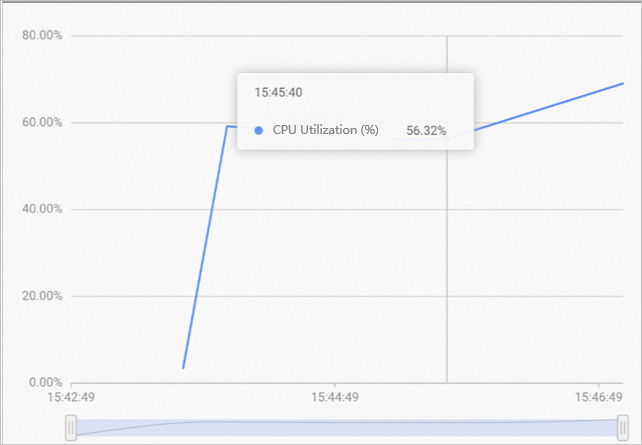
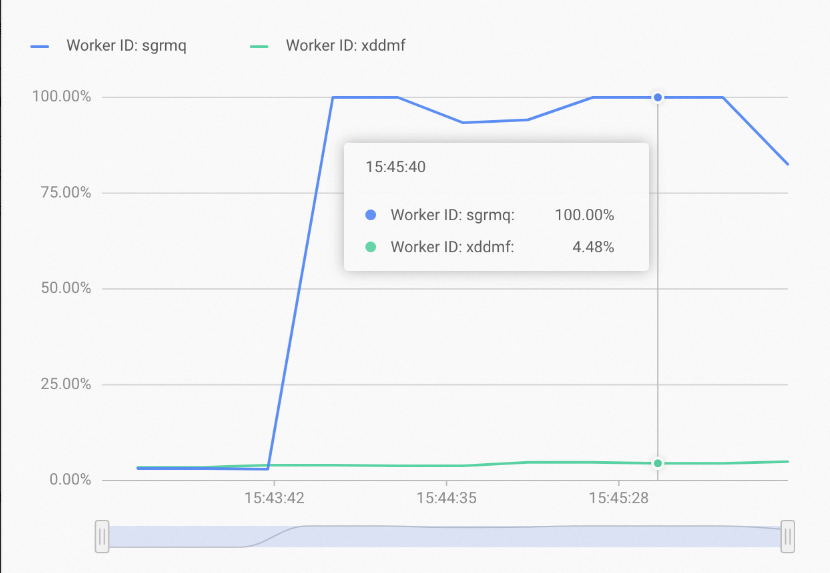
The preceding figures indicate that the CPU utilization of the instance is at a medium level, but the CPU utilization of one worker node is very low and that of the other worker node is very high. This may be caused by the uneven distribution of queries on worker nodes. Most queries are routed to only a few shards. In this case, you can increase the number of shard replicas to allow more worker nodes to have shard replicas. This can effectively improve resource usage and queries per second (QPS).
NoteMetadata synchronization between the leader shard and follower shards consumes resources. A large number of shard replicas consume a large amount of resources for data synchronization. Therefore, we recommend that you do not improve QPS by increasing the number of shard replicas unless the uneven CPU utilization between worker nodes is caused by the uneven distribution of queries.
Data queries on the leader shard or follower shards have a latency of several milliseconds.
After you increase the number of shard replicas, the resources of each worker node are fully utilized, as shown in the following figure.
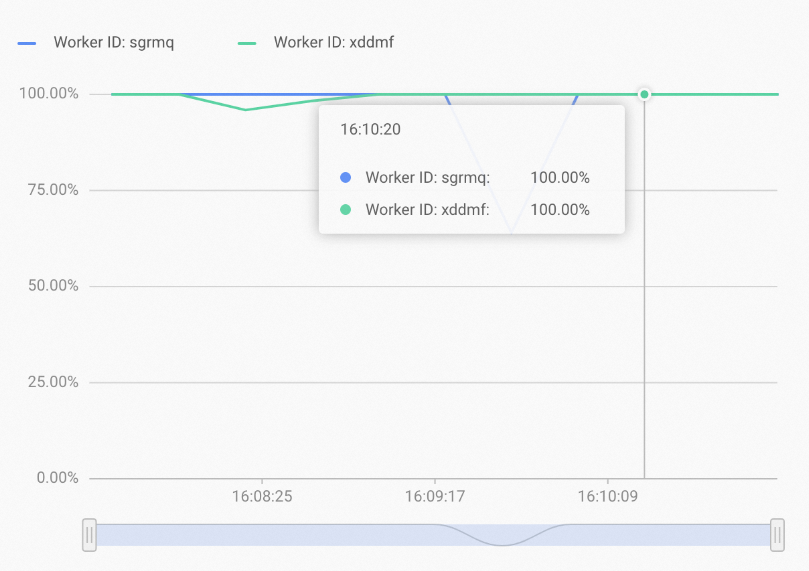
Limits
Only Hologres V1.1 and later support the shard-level replication feature. You can check the version of your Hologres instance on the instance details page in the Hologres console. If the version of your instance is V0.10 or earlier, you can manually upgrade your Hologres instance in the Hologres console or join a Hologres DingTalk group to apply for an instance upgrade. For more information about how to manually upgrade a Hologres instance, see Instance upgrades. For more information about how to join a DingTalk group, see Obtain online support for Hologres.
The value of the replica_count parameter must be less than or equal to the number of compute nodes. You can check the number of compute nodes in your Hologres instance on the instance details page in the Hologres console.
Syntax
Query the table groups in a database
To query the table groups in the current database, execute the following statement:
select * from hologres.hg_table_group_properties ;Query the replica count of each shard for a table group
Sample statement
select property_value from hologres.hg_table_group_properties where tablegroup_name = 'table_group_name' and property_key = 'replica_count';Parameters
Parameter
Description
table_group_name
The name of the table group that you want to query.
replica_count
The property that you want to query. Set the value to replica_count.
Enable the shard-level replication feature
You can enable the shard-level replication feature by modifying the replica count of each shard for a table group.
-- Change the value of the replica count parameter of each shard for a table group to a number greater than 1 to enable the shard-level replication feature. call hg_set_table_group_property ('<table_group_name>', 'replica_count', '<replica_count>');replica_count: the replica count of each shard for the table group. The value of this parameter must be less than or equal to the number of compute nodes.
Disable the shard-level replication feature
Sample statement
-- Change the value of the replica_count parameter to 1 to disable the shard-level replication feature. call hg_set_table_group_property ('table_group_name', 'replica_count', '1');Parameters
Parameter
Description
hg_set_table_group_property
The function that is used to modify the replica count of each shard for a table group.
table_group_name: the name of the table group that you want to manage.
replica_count: the replica count of each shard for the table group.
If you set the replica_count parameter to the default value 1, the shard-level replication feature is disabled. A value greater than 1 indicates that the shard-level replication feature is enabled.
Check the shard metadata that is loaded to each worker node
After you configure multiple replicas for each shard, you can check the shard metadata that is loaded to each worker node by executing the following SQL statement:
SELECT * FROM hologres.hg_worker_info;NoteBefore the metadata of a shard is loaded to a worker node, the value of worker_id for this worker node may be empty.
The following figure shows a sample result.
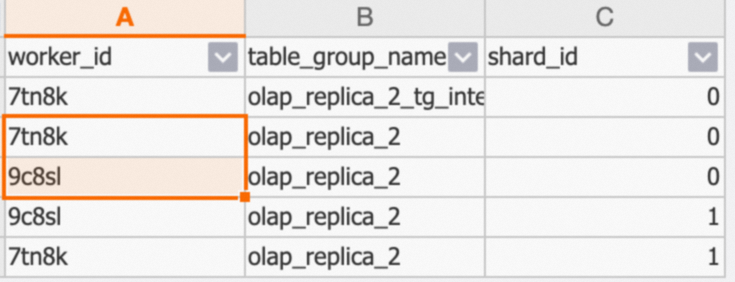
In this example, data in tables of the
olap_replica_2table group is distributed to two shards: Shard 0 and Shard 1. Both Shard 0 and Shard 1 have two replicas and their metadata is loaded to both the7tn8kand9c8slworker nodes.
Configure shard policies to achieve high availability and high throughput of queries
Description
In this example, multiple replicas are configured for a shard. The shard replicas are loaded to multiple worker nodes. Queries are randomly routed to a shard replica on a worker node, as shown in the following figure.
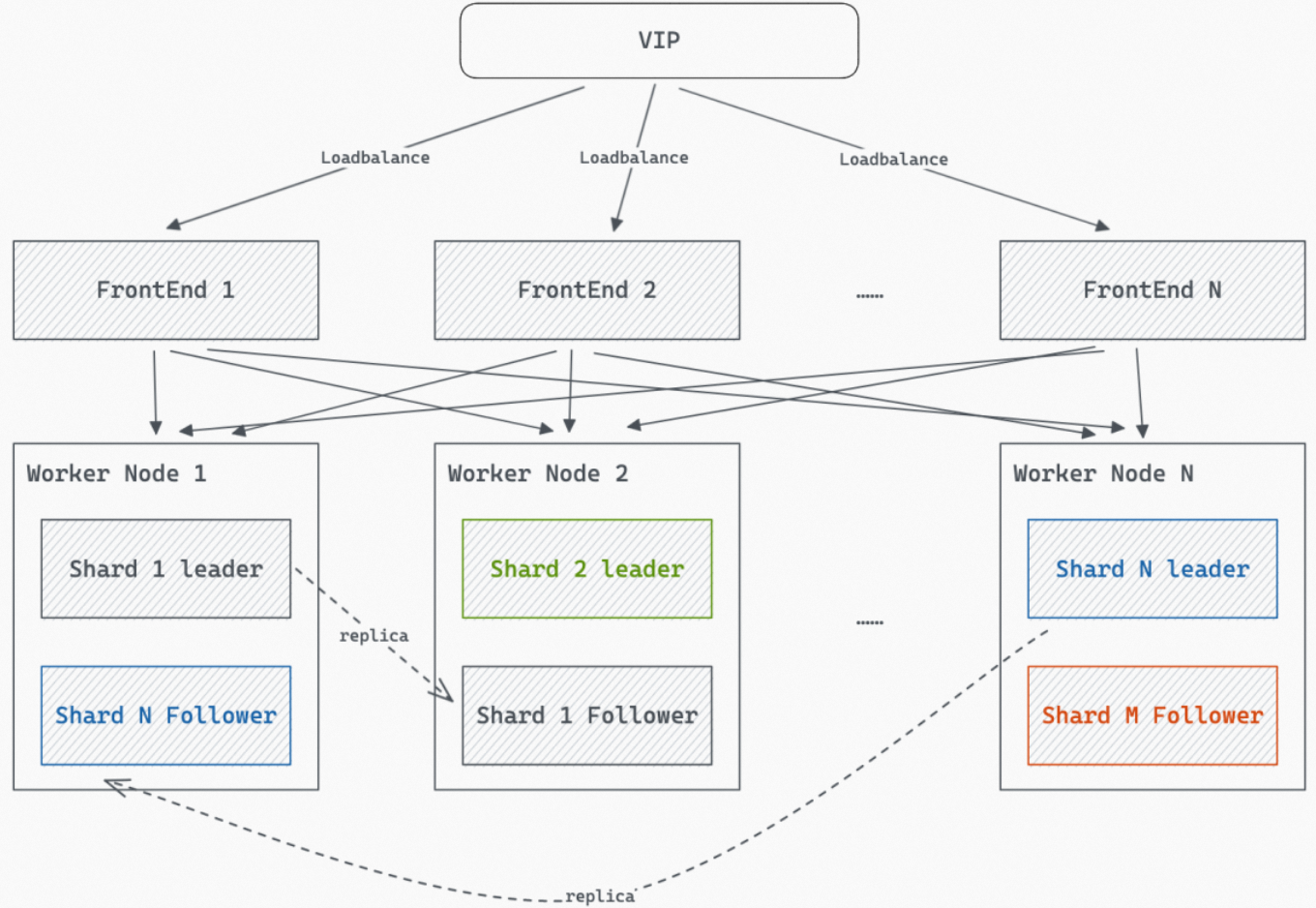
The system can route point queries to the shard replica of another worker node to ensure that results are returned for the point queries if the point queries time out. Point queries are processed by using fixed plans.
Parameter description
hg_experimental_query_replica_mode: the shard policy that is used to route queries.Scenario
Default value
Value type
Valid values
Example
All queries
leader_follower
TEXT
leader_follower: Queries are routed to the leader shard and follower shards based on a specified ratio. This is the default value.leader_only: Queries are routed to only the leader shard. In this case, even if the value of thereplica_countparameter is greater than 1, the throughput and availability cannot be improved.follower_only: Queries are routed to only follower shards. In this case, you need to set thereplica_countparameter to a value greater than 3. This way,two or more follower shards exist, and the throughput and availability can be improved.
-- Session-level configuration SET hg_experimental_query_replica_mode = leader_follower; -- Database-level configuration ALTER DATABASE <database_name> SET hg_experimental_query_replica_mode = leader_follower;hg_experimental_query_replica_leader_weight: the weight of the leader shard that is used to route queries.Scenario
Default value
Value type
Valid values
Example
All queries
100
INT
Maximum value: 10000.
Minimum value: 1.
Default value: 100.
-- Session-level configuration SET hg_experimental_query_replica_leader_weight = 100; -- Database-level configuration ALTER DATABASE <database_name> SET hg_experimental_query_replica_leader_weight = 100;For online analytical processing (OLAP) point queries, if the
replica_countparameter is set to a value greater than 1 for the table group of the table from which you want to query data, queries are routed to the leader shard and follower shards based on the values of thehg_experimental_query_replica_modeandhg_experimental_query_replica_leader_weightparameters. Examples:Example 1: If the
replica_countparameter is set to a value greater than 1 for a table group of the table from which you want to query data and the value of thehg_experimental_query_replica_modeparameter is set to leader_follower, the system routes queries to the leader shard and follower shards based on the value of thehg_experimental_query_replica_leader_weightparameter. By default, the value of the hg_experimental_query_replica_leader_weight parameter is 100, and the weight of each follower shard is also 100. If the value of thereplica_countparameter is set to 4, one leader shard and three follower shards are replicated for each shard. In this case, the leader shard and each follower shard have a25%probability to hit a query.Example 2: If the
replica_countparameter is set to a value greater than 1 for a table group of the table from which you want to query data and the value of thehg_experimental_query_replica_modeparameter is set to leader_only, the system routes queries only to the leader shard.Example 3: If the
replica_countparameter is set to a value greater than 1 for a table group of the table from which you want to query data and the value of thehg_experimental_query_replica_modeparameter is set to follower_only, the system routes queries only to the follower shards. By default, the weight of each follower shard is 100. If the value of thereplica_countparameter is set to 4, one leader shard and three follower shards are replicated for each shard. In this case, queries are routed to the three follower shards, and each follower shard has a 1/3 probability to hit a query.
hg_experimental_query_replica_fixed_plan_ha_mode: the high availability policy that is used to route point queries. Point queries are processed by using fixed plans.Scenario
Default value
Value type
Valid values
Example
Point queries (processed by using fixed plans)
any
TEXT
any: Queries are routed to shard replicas based on the values of thehg_experimental_query_replica_modeandhg_experimental_query_replica_leader_weightparameters. This is the default value.leader_first: This value takes effect only when the value of thehg_experimental_query_replica_modeparameter is set toleader_follower. This value indicates that queries are preferentially routed to the leader shard. If the leader shard is unavailable due to reasons such as timeouts, queries are routed to the follower shards.off: Queries are routed only once.
-- Session-level configuration SET hg_experimental_query_replica_fixed_plan_ha_mode = any; -- Database-level configuration ALTER DATABASE <database_name> SET hg_experimental_query_replica_fixed_plan_ha_mode = any;hg_experimental_query_replica_fixed_plan_first_query_timeout_ms: the threshold that determines timeouts of first-time point queries in high availability scenarios. After the timeout threshold is reached or exceeded, point queries are routed to another available shard. Point queries are processed by using fixed plans. For example,hg_experimental_query_replica_fixed_plan_first_query_timeout_ms=60indicates that if no result is returned for a query within 60 ms, the system routes the query to the shard on another worker node.Scenario
Default value
Value type
Valid values
Example
All queries
60
INT
Maximum value: 10000.
Minimum value: 0.
Default value: 60.
-- Session-level configuration SET hg_experimental_query_replica_fixed_plan_first_query_timeout_ms = 60; -- Database-level configuration ALTER DATABASE <database_name> SET hg_experimental_query_replica_fixed_plan_first_query_timeout_ms = 60;
Suggestions for different scenarios
Scenario 1: Multi-replica for high throughput
Scenario description: The monitoring information indicates that the CPU utilization of the instance is at a medium level, but the CPU utilization of one worker node is very low and that of the other worker node is very high. This may be caused by the uneven distribution of queries on worker nodes. Most queries are routed to only a few shards. In this case, you can increase the number of shard replicas to allow more worker nodes to have shard replicas. This can effectively improve resource usage and QPS.
Procedure
Increase the number of shard replicas.
In this example, a table group named tg_replica exists in a database. Execute the following SQL statement to set the number of replicas to 2.
-- Set the number of replicas for tables in the tg_replica table group to 2. call hg_set_table_group_property ('tg_replica', 'replica_count', '2');The system has the following default settings:
hg_experimental_query_replica_mode=leader_follower
hg_experimental_query_replica_leader_weight=100
After you increase the number of replicas, the system randomly routes queries to the worker nodes that correspond to the leader shard and follower shards. This way, QPS can be increased even for hot data queries.
Check whether a shard replica is loaded to each worker node.
Execute the following statement to check whether a shard replica is loaded to each worker node:
SELECT * FROM hologres.hg_worker_info WHERE table_group_name = 'tg_replica';The following figure shows a sample result.

The preceding figure indicates that one shard replica is loaded to multiple worker nodes. The setting succeeds.
Scenario 2: Multi-replica for high availability
Scenario description: You want to resolve the issue that queries fail if the shard on which the queries are performed fails.
Procedure
Increase the number of shard replicas.
In this example, a table group named tg_replica exists in a database. Execute the following SQL statement to set the number of replicas to 2.
-- Set the number of replicas for tables in the tg_replica table group to 2. call hg_set_table_group_property ('tg_replica', 'replica_count', '2');The system has the following default settings:
hg_experimental_query_replica_mode=leader_follower
hg_experimental_query_replica_fixed_plan_ha_mode=any
hg_experimental_query_replica_fixed_plan_first_query_timeout_ms=60
After you increase the number of replicas, the system performs different operations in different scenarios:
In OLAP scenarios, the system randomly routes queries to the worker nodes that correspond to the leader shard and follower shards. When you query data, the master node periodically checks whether each shard replica is available. The system removes unavailable shard replicas and routes queries to available shard replicas. When the unavailable shard replicas become available again, the system can route queries to them. The system takes 5 seconds to detect whether a shard replica is available and 10 seconds to remove the FE node that corresponds to the worker node to which an unavailable shard replica is loaded. Therefore, the system takes 15 seconds in total for the system to detect the issue and resume the query. After 15 seconds, the query can be performed normally.
In fixed plan scenarios, the system provides a retry mechanism. If a worker node fails, queries can be routed to the shard replicas of another worker node. The queries can succeed with the response time increased.
In some fixed plan scenarios where data must be queried immediately after it is written, you can set
hg_experimental_query_replica_fixed_plan_ha_modetoleader_firstto prevent the long latency of follower shards. In this configuration, queries are preferentially routed to the leader shard. If the queries on the leader shard time out, the queries are routed to follower shards.NoteIn this case, QPS cannot be increased for hot data queries.
Check whether a shard replica is loaded to each worker node.
Execute the following statement to check whether a shard replica is loaded to each worker node:
SELECT * FROM hologres.hg_worker_info WHERE table_group_name = 'tg_replica';The following figure shows a sample result.

The preceding figure indicates that one shard replica is loaded to multiple worker nodes. The setting succeeds.
FAQ
Problem description: After I set parameters as described in Scenario 1, queries are not routed to follower shards. The monitoring information in the Hologres console indicates that the worker node with the high load still has a high load after the configuration.
Cause: For versions earlier than Hologres V1.3, the Grand Unified Configuration (GUC) parameter
hg_experimental_enable_read_replicais provided to specify whether queries can be routed to follower shards. The default value is off. You can execute the following SQL statement to check whether the GUC parameter is set to on. The value on indicates that queries can be routed to follower shards. The value off indicates that queries cannot be routed to follower shards.SHOW hg_experimental_enable_read_replica;Solution: If the value of the
hg_experimental_enable_read_replicaparameter is off, you can execute the following SQL statement to set the GUC parameter to on at the database level.ALTER DATABASE <database_name> SET hg_experimental_enable_read_replica = on;In the statement, replace database_name with your database name.